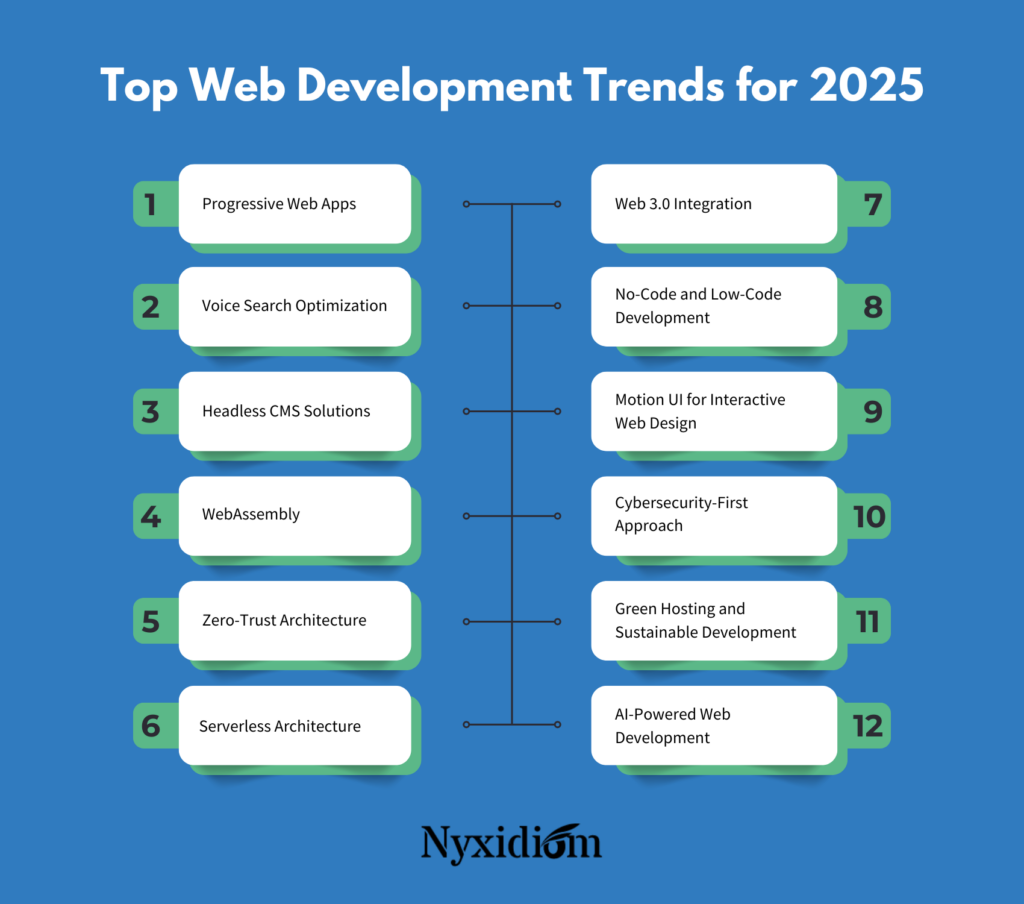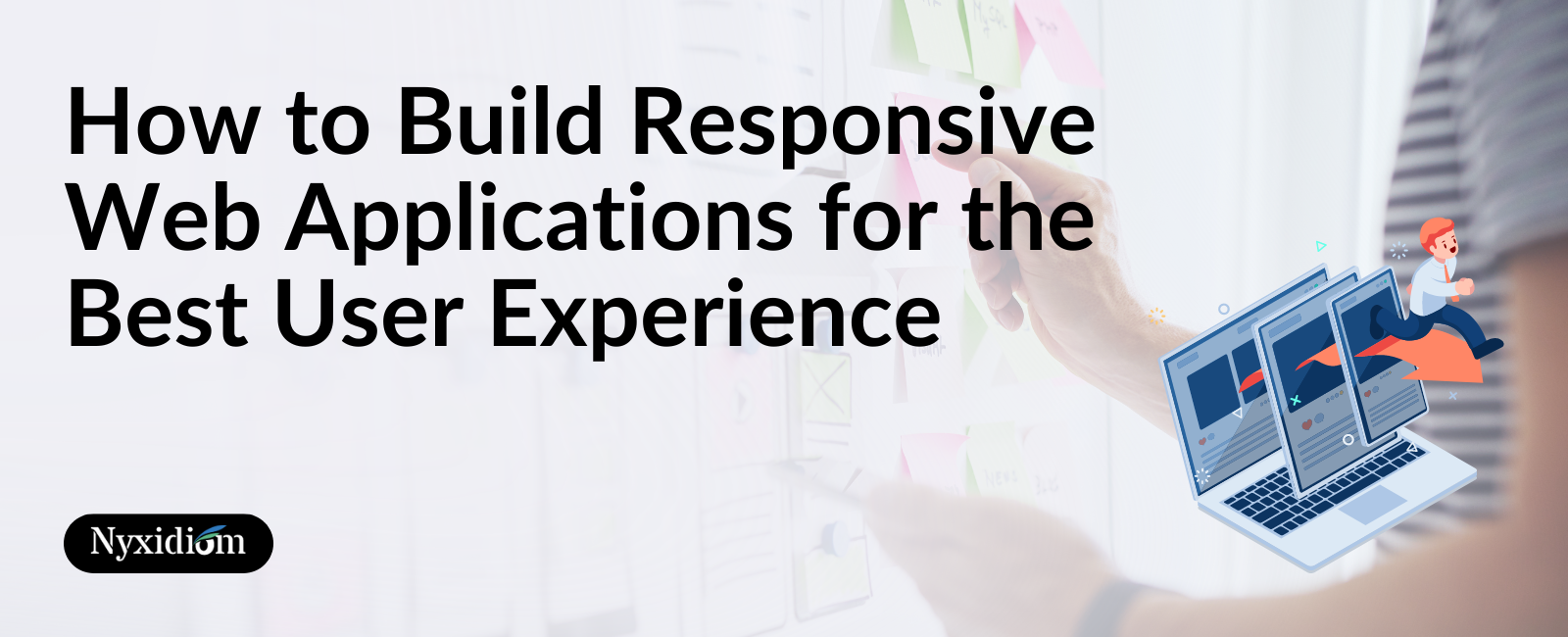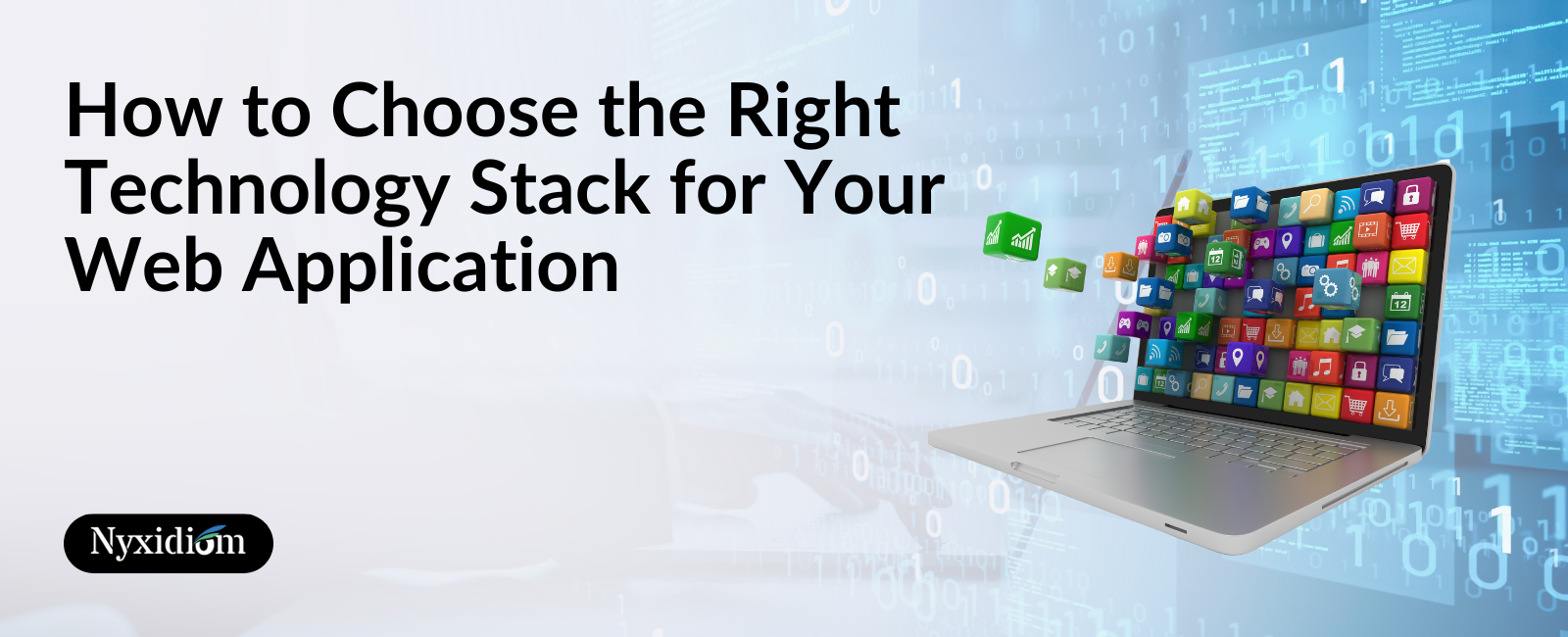Just as with any other field, website development trends evolve year by year due to innovations. To not just survive but thrive, it’s crucial to stay updated and adapt to these changes.
Here are key web development trends that business owners and web development service agencies should follow to keep websites dynamic and relevant in today’s ever-evolving digital landscape.
Top Web Development Trends for 2025
Progressive Web Apps (PWAs)
A Progressive Web App (PWA) is a type of web application that provides an app-like experience on the web, with features like offline access, push notifications, and fast load times, often making it indistinguishable from a native mobile app.
Strategy to Implement
Develop PWAs using popular frameworks like React, Vue.js, or Next.js. Use service workers to cache essential assets and content, ensuring the app works offline. Focus on responsive design to ensure a seamless experience across all devices.
Benefits
- Offline Functionality: Users can access key features of the app even when they are offline, leading to better user retention
- Cross-Platform Compatibility: PWAs work on all devices and platforms without needing separate versions for iOS or Android
- Improved SEO and Performance: Fast loading times and mobile-first indexing improve both user experience and search engine rankings
Voice Search Optimization
Voice Search Optimization refers to optimizing a website’s content and structure to ensure that it can be easily discovered and ranked for voice-based searches via digital assistants like Alexa, Google Assistant, and Siri.
Strategy to Implement
Use long-tail keywords and natural language queries to make your content more conversational. Implement structured data (schema markup) to help search engines better understand your content and rank it for voice searches.
Benefits
- Improved Search Visibility: Optimizing for voice search can increase your chances of being featured in “position zero” or featured snippets, which voice assistants prioritize
- Enhanced User Experience: Voice search-friendly content provides a quick and accessible way for users to find answers
- Competitive Edge: As voice search continues to grow, optimizing early ensures you stay ahead of competitors who may be slow to adapt
Headless CMS Solutions
A Headless CMS is a content management system where the frontend (presentation layer) is separated from the backend (content repository). This setup allows content to be managed independently and delivered through APIs to different platforms, such as websites, mobile apps, and IoT devices.
Strategy to Implement
Integrate headless CMS platforms such as Contentful or Strapi into your web architecture, enabling the seamless distribution of content across multiple channels. Pair it with a flexible frontend framework like Vue.js or Next.js for optimal performance and design flexibility.
Benefits
- Omnichannel Content Distribution: Publish content to multiple platforms at once, ensuring a consistent user experience across all digital channels
- Flexible Frontend Development: Developers have complete control over the design and functionality of the front end, as it’s not tied to the CMS
- Scalability: As your business grows, adding new channels or updating content is simplified, as all data flows through APIs
WebAssembly (Wasm)
WebAssembly (Wasm) is a binary instruction format that enables high-performance applications to run directly in web browsers. It allows developers to compile code written in languages like C, C++, and Rust to be executed in the browser at near-native speed.
Strategy to Implement
Use WebAssembly for tasks that require heavy computation, such as gaming, video editing, or data visualization. Combine it with JavaScript for less resource-intensive tasks to create a balanced, performance-optimized web application.
Benefits
- Improved Performance: WebAssembly executes complex operations faster than JavaScript, making it ideal for resource-heavy applications
- Cross-Browser Compatibility: WebAssembly runs on all modern browsers without requiring additional plugins
- Security: WebAssembly provides a secure execution environment, reducing potential vulnerabilities for web applications
Zero-Trust Architecture
Zero-Trust Architecture is a security model that assumes no device, user, or application is trusted by default, whether inside or outside the network. Every access request must be continuously authenticated and authorized, ensuring maximum security.
Strategy to Implement
Adopt a zero-trust security model by implementing multi-factor authentication (MFA), end-to-end encryption, and continuous monitoring of all access requests. Secure APIs and data exchange through encrypted tokens and granular permissions.
Benefits
- Enhanced Security: Reduces the likelihood of unauthorized access by constantly verifying the identity of users and devices
- Compliance: Ensures that your website meets data privacy regulations such as GDPR and CCPA by controlling access to sensitive data
- Proactive Threat Mitigation: AI-powered security tools can automatically detect and mitigate threats, minimizing damage from attacks

Web 3.0 Integration
Web 3.0, also known as the decentralized web, is the next evolution of the internet, characterized by blockchain technology, decentralized applications (dApps), and smart contracts. Web 3.0 focuses on giving users more control over their data, enhancing transparency, and enabling decentralized data exchange.
Strategy to Implement
Utilize blockchain technology to build decentralized web applications (dApps) that are transparent, secure, and user-centric. Use tools like Ethereum or Polkadot to implement smart contracts, ensuring secure peer-to-peer transactions.
Benefits
- Decentralization: Web 3.0 eliminates the need for intermediaries, enabling direct interactions between users, and making transactions more transparent and secure
- Enhanced Security: Blockchain technology ensures that data is immutable and secure, reducing the risks of data breaches and fraud
- Data Ownership: Users can own and control their data, providing more privacy and security compared to centralized systems
No-Code and Low-Code Development
No-code and Low-Code Development platforms allow users to build applications with minimal or no coding knowledge by using visual interfaces and pre-built components. These platforms simplify app development for businesses by reducing the need for a large development team.
Strategy to Implement
Use no-code platforms like Bubble or Webflow to quickly prototype applications or create full-scale websites without extensive coding knowledge. For more complex projects, use low-code platforms like OutSystems to build custom applications with minimal manual coding.
Benefits
- Faster Time-to-Market: With pre-built modules and drag-and-drop functionality, businesses can build and launch applications quickly, reducing development cycles
- Cost-Effective: No-code/low-code platforms reduce the need for large development teams, cutting down on project costs
- Empowerment for Non-Developers: Enables non-technical team members to contribute to building and updating applications, fostering collaboration and innovation
Motion UI for Interactive Web Design
Motion UI involves the use of animations, transitions, and micro-interactions to create dynamic and interactive web designs. It enhances user experience by making navigation intuitive and providing feedback on user actions.
Strategy to Implement
Incorporate motion UI elements using frameworks like Framer Motion or GreenSock to create smooth animations for buttons, sliders, or page transitions. Focus on micro-interactions and small animations triggered by user actions (e.g., hover effects, button clicks) to improve engagement.
Benefits
- Enhanced User Experience: Motion UI guides users smoothly through a website, improving navigation and user satisfaction
- Increased Engagement: Interactive design elements can boost user engagement and retention by making the website more visually appealing
- Feedback and Clarity: Micro-interactions provide feedback on user actions, improving the overall usability of the site
Cybersecurity-First Approach
A Cybersecurity-First Approach refers to designing web applications with security as the highest priority, ensuring that all layers of the application from infrastructure to data handling are protected against evolving cyber threats.
Strategy to Implement
Adopt a proactive cybersecurity-first strategy by integrating security features such as multi-factor authentication (MFA), end-to-end encryption, and regular security audits. Implement best practices like OWASP guidelines and tools like Snyk for vulnerability scanning.
Benefits
- Reduced Risk of Breaches: By focusing on security from the beginning, the risk of data breaches and hacking attempts is minimized
- Compliance with Regulations: Security-first development helps ensure compliance with data privacy laws like GDPR, CCPA, and HIPAA
- Increased Trust: Secure applications foster trust with users, leading to higher engagement and retention
Serverless Architecture
Serverless Architecture lets developers build and run applications without worrying about managing servers. Cloud providers like AWS, Google Cloud, or Azure take care of the server management, so developers can just focus on writing code.
Strategy to Implement
Use cloud functions (e.g., AWS Lambda, Azure Functions) to handle backend logic without provisioning servers. Implement microservices to break down the application into independent services that scale automatically based on demand.
Benefits
- Cost Efficiency: You only pay for the computing resources you use, eliminating the need to manage idle servers
- Automatic Scaling: Serverless architecture automatically scales with demand, ensuring high availability without manual intervention
- Faster Development: Developers can focus on writing code and deploying features quickly without worrying about server maintenance
Explore our Cloud Solutions service page to learn more
Green Hosting and Sustainable Development
Green Hosting refers to web hosting services powered by renewable energy sources, designed to minimize the environmental impact of websites by reducing energy consumption. Sustainable Development in web development focuses on creating optimized, efficient websites that consume fewer resources and lower carbon emissions.
Strategy to Implement
Select green hosting providers such as GreenGeeks or Kualo that run on renewable energy. Optimize your website’s performance by reducing image sizes, using efficient code, and enabling lazy loading for content to decrease energy consumption.
Benefits
- Reduced Carbon Footprint: Green hosting significantly reduces the environmental impact of your website, making it more sustainable
- Improved Website Performance: Sustainable development practices result in faster-loading websites, improving user experience and search engine rankings
- Positive Brand Image: Businesses that adopt eco-friendly practices can improve their reputation and appeal to environmentally-conscious consumers
AI-Powered Web Development
Artificial Intelligence (AI) in web development refers to the integration of AI technologies to automate tasks, improve user experiences, and enhance website performance through machine learning and predictive algorithms.
Strategy to Implement
Utilize AI-powered development tools for automated code suggestions and AI-driven analytics platforms to monitor and optimize user engagement. Additionally, integrate AI chatbots and AI-based recommendation engines to provide personalized content to users in real time.
Benefits
- Automated Workflows: Streamlines coding and testing processes, reducing manual errors and speeding up development
- Personalized User Experience: Offers tailored recommendations and content, increasing user engagement and satisfaction
- Enhanced Security: AI-based threat detection tools can proactively identify security vulnerabilities and prevent potential cyberattacks
Top Web Development Tools for 2025
- React and Vue.js: Ideal for building dynamic, single-page applications with modular components and reactivity
- Remix: A modern framework designed for optimized web performance and seamless user experience. It offers server-side rendering (SSR), built-in routing, and enhanced form handling, making it great for building fast, scalable web apps with minimal effort
- WebAssembly (Wasm): Best for creating performance-intensive web applications like gaming, video editing, and data analysis tools
- Headless CMS (Strapi, Contentful): Streamlines content management and delivery across multiple platforms using APIs
- JAMstack: A web architecture that uses JavaScript, APIs, and markup to deliver fast, scalable, and secure websites
What to Think About When Choosing Web Development Tools
Choosing the right tools is essential for the success of your project. Here are some key considerations for selecting web development tools in 2025
- Scalability: Ensure that the tools you select can scale with your project as it grows in complexity and user base
- Performance: Opt for tools that prioritize speed, low latency, and high availability, especially for real-time or high-traffic applications
- Security: Choose tools that come with built-in security features or are easily integrated with security protocols like SSL, MFA, and encryption
- Flexibility: Ensure the tools allow for customization and integrations with other platforms, APIs, or services, making it easier to adapt to changing requirements
How Nyxidiom Helps You with the Latest Web Development Trends
Our expertise in using advanced frameworks combined with our focus on DevOps practices, helps us deliver robust, scalable, and secure web solutions.
How We Help
- Custom PWA Development: We build Progressive Web Apps that deliver fast, responsive, and engaging user experiences, optimized for all devices
- API-First Architecture: Our API-first approach enables the flawless integration of different services and ensures scalability for web and mobile platforms
- Security: We implement the latest security standards to ensure your applications are protected against evolving cyber threats
- Edge Computing: We help reduce latency and improve application performance by implementing edge computing strategies that process data closer to the user
At Nyxidiom, we craft custom web applications that fit your business perfectly. Using the latest technology and best practices, we create high-quality solutions that help your business succeed. Partner with us to turn your ideas into reality with ease and expertise.



